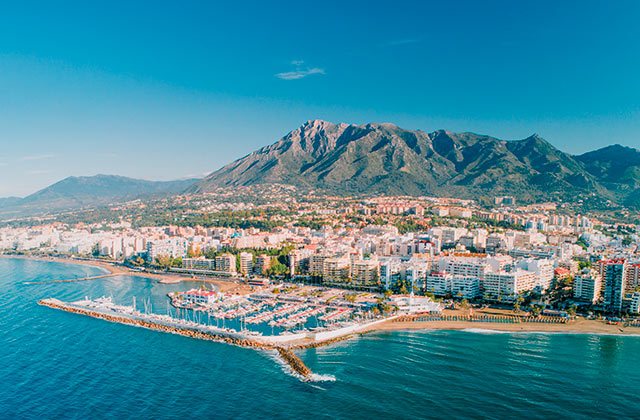
The city of Marbella on the Costa del Sol – often called the Spanish Riviera – is globally recognised as an exclusive holiday destination and summer residence for the rich and famous. It’s been associated with celebrities past and present including Sean Connery and Sophia Loren, Rod Stewart and Antonio Banderas, Simon Cowell and Alan Sugar, Roman Abramovich and Vladimir Putin.
From its humble beginnings as an ancient Moorish town, Marbella has transformed itself from a fishing and farming village into a major tourist destination and commercial centre over the last 50 years or so. Today, the city’s attractions go far beyond its uniquely mild climate and over 25km of golden sandy beaches – there are over 10 golf courses, 3 marinas, luxury hotels aplenty and all the shopping, eating and entertaining you could possibly wish for.
But how did Marbella get to become so rich and famous? Looking back to the end of World War II, 4 influential men are largely responsible for making Marbella what it is today.
- Prince Alfonso von Hohenlohe
Marbella was ‘discovered’ by Prince Alfonso and his father, the German Prince Maximilian von Hohenlohe-Langenburg. Allegedly, they visited the area in 1947 for a picnic when their Rolls Royce broke down. Alfonso fell in love with the charming fishing village, bought some land for himself and some wealthy friends and built a house, Finca Margarita.
When the residence became increasingly popular as the holiday ‘go to’ for Alfonso’s circle of well-to-do friends, the shrewd businessman turned it into the Costa del Sol’s first luxury hotel. Having persuaded a distant German cousin, Count Rudolf von Schönburg, to manage the new hotel for him, the Marbella Club opened its doors in 1954.
Alfonso was well connected to Europe’s ruling elite, so promoting the Club to wealthy industrialists, bankers and aristocrats proved spectacularly successful. Hollywood stars including Audrey Hepburn and James Stewart started to arrive in increasing numbers, adding more glitz and glamour, and the Marbella Club on what is now known as the Golden Mile, became the epicentre of the city’s rising fortunes.
- King Fahd of Saudi Arabia
The 1970s and 1980s saw an even sharper upturn in Marbella’s popularity and development as an international luxury tourist destination. This was largely due to the influence of the then Prince Fahd of Saudi Arabia (who became King in 1982) who took a shine to the area, believing it to be ‘a land blessed by Allah’. He purchased land and built an extravagant residence in the city. Mar-Mar Palace is a compound reminiscent of the White House in Washington, complete with a private clinic and a mosque.
King Fahd’s virtually unlimited spending during his visits to Marbella are the stuff of legend. Bringing with him a royal entourage of thousands of staff, he loved to spend most summers in Marbella. And spend he did – in fact, King Fahd is said to have boosted the local economy to the tune of 40-80 million euros per year! With those kind of numbers, it is no exaggeration to say that the Arab King single-handedly transformed the economic fortunes of Marbella and the surrounding Costa del Sol.
King Fahd’s contribution to the city’s wealth was recognised by naming a public garden (Jardin del Rey Fahd) and a street (Boulevard del Rey Fahd) after him following his death in 2005, in addition to honouring his passing with 3 days’ official mourning.
While Fahd’s successors have chosen not to continue the same level of elaborate spending in the Costa del Sol, subsequent visits by the family have still generated millions of euros for Marbella.
- José Banus
In 1970, a local property developer decided to embark on a major project on the Costa del Sol, southwest of Marbella. Puerto Banus, as it is now famously known, was the brainchild of José Banus who saw a commercial opportunity to provide Marbella’s international elite with an exclusive marina complex.
Guided by his architects, Banus was persuaded to change his original designs to build spectacular skyscrapers in the area, opting for a more traditional architectural style in keeping with the Mediterranean character of a quaint Andalusian fishing village.
To say that the development was a success would be a massive understatement. Puerto Banus is now one of the largest entertainment centres on the Costa del Sol, boasting 5 million visitors per year with a raft of A-list celebrities among them.
- Jesus Gil y Gil
The flamboyant Spanish businessman and politician Jesus Gil was Mayor of Marbella between 1991 and 2002. Having made his fortune in the construction industry, including serving a prison sentence for his part in the collapse of one of his ‘urbanisation’ developments, he also served as president of Atletico Madrid Football Club.
Politically, Gil was a controversial figure who held extreme right-wing views. Not unlike President Trump, some would argue, his personal brand contained elements of low brow populism, self-aggrandisement, misogyny, homophobia and xenophobia. He was an outspoken, foul-mouthed critic and a Franco sympathiser.
A well-connected business tycoon, Gil continued to develop Marbella commercially with infrastructure and offices, while promoting the city further as a luxury resort. Parks and golf courses, cultural centres and sports arenas all flourished during his tenure as Mayor.
Author: Dakota Murphey